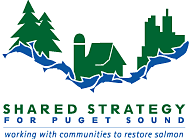|
WSDOT Uses Local Priorities to Identify Mitigation Sites Local salmon conservation priorities are finding their way into Washington State Department of Transportation’s (WSDOT) mitigation projects when interests overlap. WSDOT has participated in a variety of watershed-based programs during the last decade. More recently, WSDOT began implementing a more formal, scientific approach to watershed assessment, using a GIS-based approach and data from local sources. Traditional mitigation techniques focused on a narrow “project by project” or “on-site” review and analysis. This focus can lead to mitigation that treats symptoms rather than core causes. Continued decline in the health of aquatic ecosystems and the species associated with them indicate that the old ways were not working. WSDOT’s new watershed characterization methodologies seek a more complete understanding of project effects, seek to assess the condition of surrounding natural resources, and to identify potential mitigation options that have the greatest opportunity for maximizing environmental benefit while reducing mitigation costs. To maximize environmental benefits, the efforts focus on the recovery of ecosystem processes. In Western Washington, key ecological processes include delivery and routing of water, sediment, pollutants, large wood, heat, and habitat integrity/connectivity. Richard Gersib, the Watershed Program Manager and Tim Hilliard, Watershed Specialist at WSDOT believe that an important aspect of this approach is to use local jurisdictions’ information and hard data as well as locally determined recovery priorities for mitigation when they satisfy mitigation needs and fall within targeted recovery areas. This level of coordination means that WSDOT is using compatible results and delineations of watershed sub-units such as drainage areas. It also means that they don’t have to reinvent the wheel to identify and prioritize significant mitigation sites. WSDOT is in the final stages of a “real world test” of the watershed characterization methodology. This test is expected to result in a list of appropriate potential mitigation sites in the watersheds impacted by the widening of Interstate 405 between the Cedar River and I-90 junction. Local coordination included consultations with King County, the Muckleshoot Tribe, and the three cities affected by the project (Bellevue, Newcastle and Renton). WSDOT also informed elected officials serving on the I-405 Steering Committee and local and agency staff serving on the I-405 Technical Committee. WSDOT used several local sources to identify local priority projects and “recovery themes” that fit within their mitigation area from several local sources:
Up to ten sites overlapped and floated to the top of the list. Gersib and Hilliard expect to provide a status report to local stakeholders by the end of the month. The level of local coordination and information sharing inherent in the watershed characterization method allows for efficiencies of scale that would otherwise not be possible. Smaller jurisdictions have access to data and GIS maps that they would otherwise not be able to afford themselves. Larger jurisdictions, such as King County, with responsibility to provide similar data, do not have to duplicate studies. The work salmon recovery planners are doing is being put to broader use as well. Both salmon and taxpayers reap the benefits. |
||||||||||||||||||||
